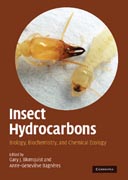
Insect hydrocarbons: biology, biochemistry, and chemical ecology
Blomquist, Gary J.
Bagnères, Anne-Geneviève
A unique and critical analysis of the wealth of research conducted on the biology, biochemistry and chemical ecology of the rapidly growing field of insectcuticular hydrocarbons. Authored by leading experts in their respective fields, the twenty chapters show the complexity that has been discovered in the nature and role of hydrocarbons in entomology. Covers, in great depth, aspects ofchemistry (structures, qualitative and quantitative analysis), biochemistry (biosynthesis, molecular biology, genetics, evolution), physiology, taxonomy, and ecology. Clearly presents to the reader the array of data, ideas, insights and historical disagreements that have been accumulated during the past half century. An emphasis is placed on the role of insect hydrocarbons in chemical communication, especially among the social insects. Includes the first review on the chemical synthesis of insect hydrocarbons. The material presented is a major resource for current researchers and a source of ideas for new researchers. INDICE: Part 1. Chemistry, Biochemistry and Physiology: 1. Introduction: History and overview of insect hydrocarbons Gary J. Blomquist and Anne-Geneviève Bagnères; 2. Structure and analysis of insect hydrocarbons Gary J. Blomquist; 3. Biosynthesis of cuticular hydrocarbon Gary J. Blomquist; 4. Molecular biology and genetics of hydrocarbon production Claude Wicker-Thomas and Thomas Chertemps; 5. Site of synthesis, mechanism of transport and selective depositionof hydrocarbons Anne-Geneviève Bagnères and Gary J. Blomquist; 6. Cuticular and water balance Allen Gibbs and Subhash Rajpurohit; 7. Chemical taxonomy withhydrocarbons Anne-Geneviève Bagnères and Claude Wicker-Thomas; 8. Chemical synthesis of insect cuticular hydrocarbons Jocelyn Millar; 9. Oxygenated derivatives of hydrocarbons James S. Buckner; Part II. Chemical Communication: 10. Perception and olfaction of cuticular compounds Mamiko Ozaki and Ayako Wada-Katsumata; 11. Nestmate recognition in social insects and the role of hydrocarbons. Jelle S. van Zweden and Patrizia d'Ettorre; 12. Cuticular hydrocarbon cues in the formation and maintenance of insect social groups Michael Green; 13. Hydrocarbon profiles indicate fertility and dominance status in ant, bee, and wasp colonies Juergen Liebig; 14. Chemical deception/mimicry using cuticular hydrocarbons Anne-Geneviève Bagnères and Cristina Lorenzi; 15. Behavioral and evolutionary roles of cuticular hydrocarbons in Diptera Jean-François Ferveur and Matthew Cobb; 16. Contact recognition pheromones in scorpions and spiders Marie Trabalon and Anne-Geneviève Bagnères; 17. Hydrocarbons as contact pheromonesof longhorned beetles Matthew D. Ginzel; 18. Polyene hydrocarbons, epoxides, and related compounds as components of lepidopteran pheromone blends Jocelyn Millar; 19. Volatile hydrocarbon pheromones from beetles Robert Bartelt; 20. New areas of research on insect hydrocarbons and conclusion Abraham Hefetz, Claude Wicker-Thomas and Anne-Geneviève Bagnères.
- ISBN: 978-0-521-89814-0
- Editorial: Cambridge University
- Encuadernacion: Cartoné
- Páginas: 504
- Fecha Publicación: 04/02/2010
- Nº Volúmenes: 1
- Idioma: Inglés
